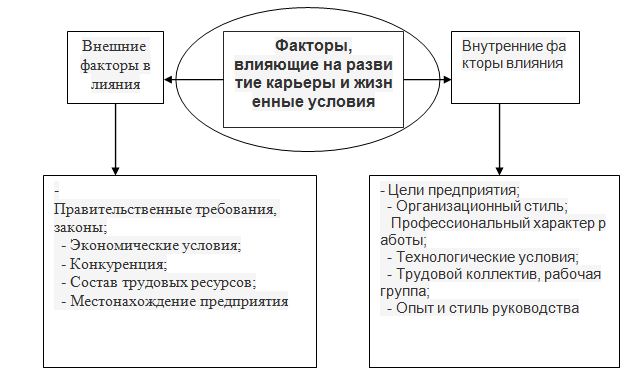
Braking: the determining factors
Content
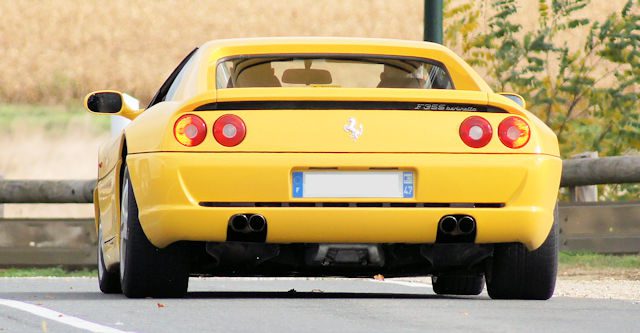
After we have seen the determinants of good handling, let's now look at braking. You will see that there are more variables than you think, and that this is not limited to the size of the disc and pads.
It should be quickly remembered that braking is about converting kinetic energy into heat using mechanical or electrical devices (when it comes to electromagnetic brakes, which can be seen on trucks, hybrid and electric cars).
Obviously, I invite the most knowledgeable to enrich the article by submitting ideas at the bottom of the page, thanks to them in advance.
See also:
- Driving behavior: determining factors
- Variables that can trick an automotive tester
Tires
Tires are critical to braking because they will experience most of the physical limitations. I often repeat, but it seems unreasonable to save on this point ... Even drivers with disabilities should give preference to quality tires (the difference is really noticeable ...).
Eraser type
First of all, it is a rubber that will be of more or less good quality, with an obvious advantage for those who have a rubber of the first choice. But in addition to quality, the rubber will also be soft, with better handling with a soft compound and better wear resistance with a hard compound. However, be careful, soft rubber in extreme heat can become too soft and cause rolling. In very hot countries, you need to adapt by wearing harder rubber, a bit like we do in winter with winter tires (which have softer rubber to adapt to the cold).
Then there are tread patterns with tires that will be more efficient in the asymmetric and even better direction. The symmetrical ones are the simplest and the cheapest because they are exactly symmetrical... In short, they are rougher and less technically advanced.
You should be aware that rubber breaks when braking, and that the shape of the sculptures will be critical to improving traction. Engineers then design shapes that maximize tire-to-road contact under these conditions.
On land, and you should already know this, it is preferable to have a smooth surface (prohibited on public roads), that is, no sculpture and completely smooth! In fact, the more the surface of the tire is in contact with the road, the more grip you have with it, and therefore the more the brakes will work.
Dimensions ?

Tire size is also critical, and it makes sense, since the larger the tire size, the better the grip, and hence, again, the brakes will work with greater intensity. Thus, this is the first value in terms of dimensions: 195/60 R16 (here the width is 19.5 cm). Width is more important than diameter in inches (which many "tourists" limit themselves to looking at ... forgetting about the rest).
The thinner you are, the easier it will be to block the wheels during hard braking. Thus, the thinner the tires, the less role the brakes can play ...
Note, however, that on very wet (or snowy) roads, it is better to have thinner tires, because then we can collect the maximum weight (hence the car) on a small surface, and support is more important in a small area. traction will then be promoted (so a slippery surface deserves more support to compensate) and an especially small tire will split water and snow (better than a wide tire that will hold too much between the road and the rubber). This is why the tires are as wide as those on the AX Kway in snow rallies ...
Inflation?
Inflating a tire will have an effect very similar to the tenderness of rubber... Indeed, the more a tire is inflated, the more it will behave like hard rubber, and so in general it's better to be a little low than too high. However, be careful, insufficient air pressure entails the risk of an explosion at high speed, which is one of the worst things that can happen to a driver, so never laugh about it (look at your car from time to time). Allows you to avoid this because an under-inflated tire is visible quickly. The rule is to check the pressure in it every month).
So when braking, we have a little more grip with a less inflated tire, simply because we have more surface in contact with the road (more compression causes the tire to be flat on the ground, which is more important.). With a very inflated tire, we will have less surface in contact with the bitumen and we will lose the softness of the tire as it will deform less, then we will more easily block the wheels.
At the top, the tire is less inflated, so it spreads over a larger bitumen surface, which reduces the risk of slipping.
Also note that inflating with normal air (80% nitrogen and 20% oxygen) will increase the hot pressure (oxygen that expands), while tires with 100% nitrogen will not have this effect (nitrogen stays good).
So don't be surprised to see +0.4 bar more when you measure hot pressure, knowing you have to do it cold if you want to see real pressure (when hot it is very misleading).

Braking device
All cars have oversized brakes a priori, since they all have ABS. This is where we realize that good braking depends primarily on the synergy between the tire and the braking device.
Good braking with small tires or bad gums will cause regular lockups and therefore ABS activation. Conversely, very large tires with medium brakes will cause a long braking distance without the wheels being able to lock up. In short, favoring one too much or favoring the other too much is not very wise, the more braking power is boosted, the more you have to do so that the rubber can follow it.
So let's take a look at some of the characteristics of the braking devices.
Disk size
The larger the disc diameter, the larger the friction surface of the pads during one wheel revolution. This means that there will be more time to cool down between the two laps at the surface, and therefore we will have more prolonged braking (whether it is the clutch of several brakes or the same braking: hard braking at 240 km / h implies that good endurance because the discs will be subject to friction over a long distance / long period of time).
Therefore, we will systematically have larger brakes at the front and smaller at the rear, because 70% of the braking is taken up by the front, and the rear largely serves to provide stability when braking (otherwise the rear logically wants to pass in front. A car that does not stick straight with high downforce, you need to constantly adjust this while driving).
Disc types
As you might guess, there are several types of discs. First of all, these are hard disks and ventilated disks. A solid disk is an ordinary "round metal" plate that easily accumulates heat due to the Joule effect (here it is embodied in the form of mechanical friction that causes heating). The ventilated disk is actually a hollow disk in the center, it can also be seen as two disks glued together with a gap in the middle. This cavity prevents too much heat from accumulating because air is a much smaller conductor of heat and stores less heat (in short it is a good insulator and a poor conductor of heat) and so it will heat less than a full equivalent (so with the same disk thickness).
Then comes the hard and perforated discs, with a fairly similar difference between the hard and ventilated discs. Basically we drill holes in the discs to improve the cooling of the discs. Finally, there are grooved discs that are most effective: they cool better than full discs and are more stable than drilled discs, which are not as uniform in temperature (precisely because of the holes). And since the material becomes brittle when heated unevenly, we can see cracks appear here and there over time (risk of disc breakage, which is a disaster when it happens while driving).
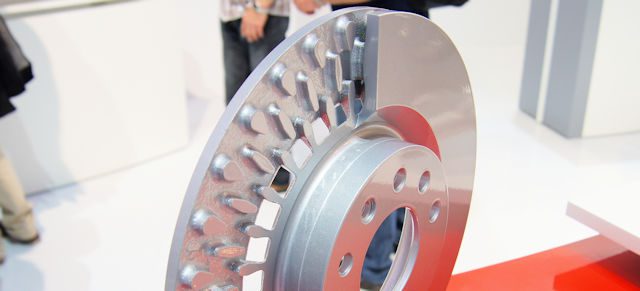
Here's a vented disc
Alternative discs such as carbon / ceramic for increased endurance. Indeed, this type of rim works at higher temperatures than is better for sporty driving. Typically, a conventional brake starts to overheat when the ceramic reaches cruising temperature. Therefore, with cold brakes, it is better to use conventional discs, which perform better at low temperatures. But for sports riding, ceramics are better suited.
When it comes to braking performance, we shouldn't hope for more with ceramics, it's primarily the disc size and number of caliper pistons that will make a difference (and between metal and ceramic, it's primarily wear rate and operating temperature change).
Types of platelets

As with tyres, skimping on pads is not the smartest way to go because they go a long way in shortening your stopping distance.
On the other hand, you should know that the more quality pads you have, the more they will wear out the discs. This is logical, because if they have more frictional power, they will sand the discs a little faster. Conversely, you put in two bars of soap instead, you wear out your discs in a million years, but the braking distance will also be an eternal dock ...
Finally, note that the most efficient pads tend to produce a whooshing noise when braking when temperature is not critical.
In short, from worst to best: organic spacers (kevlar / graphite), semi-metallic (semi-metallic / semi-organic) and finally cermet (semi-sintered / semi-organic).
Types of stirrups
The caliper type primarily affects the friction surface associated with the pads.
First of all, there are two main types: floating calipers, which are quite simple and economical (hooks on one side only ...), and fixed calipers, which have pistons on either side of the disc: then it folds down and then we can use here higher braking forces, which does not work well with a floating caliper (which is therefore reserved on lighter vehicles that receive less torque from the master cylinder).
Then there is the number of pistons that push the pads. The more pistons we have, the larger the friction surface (pads) on the disc, which improves braking and reduces their heating (the more heat is distributed over a high surface, the less we achieve critical heating). To summarize, we can say that the more pistons we have, the larger the pads will be, which means that more surface area, more friction = more braking.
To understand the cartoons: if I press a 1cm2 pad on a rotating disc, I have a little braking and the pad will overheat very quickly (since braking is less important, the disc spins faster and takes longer, which causes the pad to get very hot). If I press with the same pressure on a 5 cm2 pad (5 times more), I have a larger friction surface, which therefore will brake the disc faster, and a shorter braking time will limit overheating of the pads. (To obtain with the same braking, the friction time will be shorter, and therefore the less friction, the less heat).
The more pistons I have, the more it presses on the disc, which means better brakes
The position of the caliper in relation to the disc (further forward or backward) will have no effect, and the position will be related to practical aspects or even cooling (depending on the aerodynamic shape of the wheel arches, it is more advantageous to place them in one position or another).
Mastervac / servo brake
The latter helps with braking because neither foot has the strength to push hard enough on the master cylinder to achieve significant braking: the pad rests on the discs.
For more effort, there is a brake booster that gives you extra energy to push the brake pedal. And depending on the type of the latter, we will have more or less sharp brakes. On some PSA cars, it is usually set too hard, so much so that we start knocking as soon as we touch the pedal. Not suitable for braking control in sporty driving ...
In short, this element can help improve braking, although in the end it is not quite the case ... In fact, it just simplifies the use of the braking capabilities offered by the discs and pads. Because it’s not because you have better help, you have a car that brakes better, this parameter is mainly taken by calibrating discs and pads (help just makes hard braking easier).
Brake fluid
The latter must be changed every 2 years. Otherwise, it accumulates water due to condensation, and the presence of water in the LDR causes gas formation. When heated (when the brakes reach temperature) it evaporates and therefore turns into gas (steam). Unfortunately, this vapor expands when hot, and then it pushes on the brakes and makes it feel loose when braking (because the gas is easily compressed).

Geometry / chassis
The geometry of the undercarriage will also be a variable that needs to be considered because when the car slows down hard, it crashes. A bit like a tire tread pattern, crushing will give a different shape to the geometry, and this shape should be conducive to good braking. I don’t have much of an idea here, and therefore I cannot give more details on the forms that favor a shorter stop.
Poor parallelism can also cause traction to the left or right when braking.
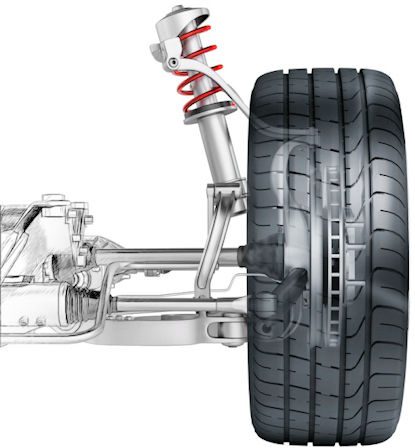
Shock absorbers
Shock absorbers are considered to be the determining factor when braking. Why ? Because it will or will not contribute to the contact of the wheel with the ground ...
However, let's say that on a perfectly flat road, shock absorbers will not play an important role. On the other hand, on a road that is not ideal (in most cases), this will allow the tires to be as tight as possible on the road. Indeed, with worn shock absorbers, we will have a small effect of wheel rebound, which in this case will be a small fraction of the time in the air, and not on the asphalt, and you know that braking the wheel in the air does not allow you to slow down.
Aerodynamics
Vehicle aerodynamics affect braking in two ways. The first has to do with aerodynamic downforce: the faster the car goes, the more downforce it will have (if there is a spoiler and depending on the setting), so braking will be better because the downforce on the tires will be more important. ...
Another aspect is the dynamic fins that are becoming trendy on supercars. It is about controlling the wing during braking in order to have an air brake, which thus provides additional stopping power.
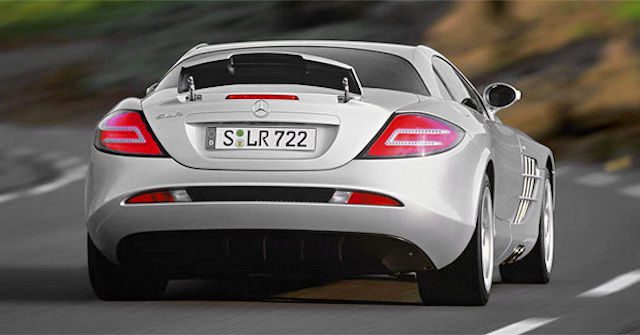
Engine brake?
It is more efficient on gasoline than diesel because the diesel runs without excess air.
The electric will have regeneration, which will allow it to be simulated with a more or less strong intensity in accordance with the setting of the energy recovery level.
Hybrid / electric trucks and passenger cars have an electromagnetic braking system, which consists of energy recovery through an electromagnetic phenomenon associated with the integration of a permanent magnet rotor (or not ultimately) into a winding stator. Except that instead of recuperating energy in the battery, we throw it in the trash in resistors that turn this juice into heat (very stupid from a technical point of view). The advantage here is to get more braking force with less heat than friction, but this prevents a complete stop, because this device brakes more when we go fast (there is a speed difference between the rotor and the stator). The more you brake, the less important the difference in speed between the stator and rotor, and, in the end, less braking (in short, the less you drive, the less braking).
Brake control device
Brake distributor
Slightly related to the geometry we just saw, the brake distributor (now controlled by the ABS ECU) prevents the car from sinking too much when braking, meaning the rear doesn't rise too much and the front doesn't. too many crashes. In this case, the rear axle loses grip/traction (and therefore when braking...) and the front end has too much weight to deal with (specifically tires that crash too hard and take on chaotic shapes, not to mention the brakes will then quickly overheat and lose their effectiveness).
ABS
So this is just an anti-lock braking system, it is designed to prevent the tires from blocking, because this is how we start to increase the braking distance, while losing control of the car.
But keep in mind that it is better to brake very hard under human control if you want to keep the distance as short as possible. Indeed, the ABS works rather crudely and does not allow for the shortest possible braking (it takes time to release the brakes in jerks, which leads to losses of micro-braking at these stages (they are, of course, very limited, but with ideally dosed and heavily applied braking we will recover).

In fact, ABS is especially important on wet roads, but also because your braking system can be improved. If I go back to the previous examples, if we have good brakes with small tires, we will easily lock up. In this case, the ABS plays an important role. On the other hand, the more generous tire / large-bore brake combination you have, the less you will need as locking will be less spontaneous ...
SWEAT
AFU (emergency braking assistance) does not contribute to shortening the braking distance in any way, but serves to "correct the psychology" of drivers. The ABS computer is actually equipped with a computer program that is used to determine if you are in emergency braking or not. Depending on how you are going to press the pedal, the program will determine if you are in an emergency (usually when you press hard on the pedal with a sharp braking stroke). If this is the case (all of this is arbitrary and was coded by engineers who tried to decipher the driver's behavior), then the ECU will initiate maximum braking even if you press the middle pedal. Indeed, people have the reflex not to push completely for fear of locking the wheels, and this unfortunately increases the stopping distance ... To overcome this, the computer brakes completely and then allows the ABS to work to avoid blocking. So we have two systems that work against each other! AFU tries to block the wheels and ABS tries to avoid it.
4 wheel steering ?!
Yes, some steering wheel systems allow better braking! Why ? Because some of them can do the same thing as beginner skiers: a snowplow. As a rule, each of the rear wheels turns in different directions in order to minimize the parallelism between them: hence the effect of a "snow plow".
Contexts
Depending on the context, it is interesting to see what this affects certain parameters of the car, let's see them.
High speed
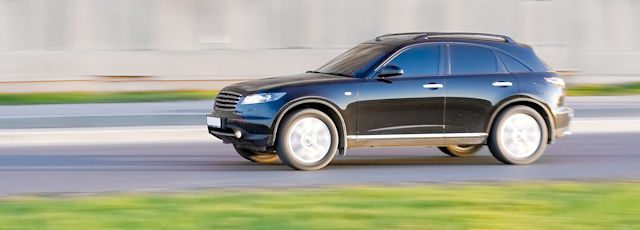
High speeds are the most difficult part of the braking system. Because the high speed of rotation of the discs means that for the same duration of pressure on the brake, the pad will rub against the same area several times. If I brake at 200, the pad over a certain period (say one second) will rub more disc surface (because there are more revolutions in 1 second than at 100 km / h), and therefore the heating will be less faster and more intense as as we drive faster. Thus, heavy braking at speeds from 200 to 0 km / h causes a lot of stress on the discs and pads.
And therefore, it is at these speeds that we can correctly measure and measure the power of the braking device.
Brake temperature

Operating temperature is also very important: pads that are too cold will slide a little more on the disc, and pads that are too hot will do the same... So you need the ideal temperature and especially note that when you first start your brakes are not optimal.
This temperature range will be different for carbon / ceramic, their operating temperature is slightly higher, which also partially reduces wear during sporty driving.
Overheating of the brakes can even melt the pads on contact with the discs, causing a kind of gas layer between the pads and the discs ... In fact, they can no longer contact, and we get the impression that there are soap bars instead. pad!
Another phenomenon: if you press the brakes too hard, you risk freezing the pads (which is less likely on high performance pads). Indeed, if they are exposed to too high a temperature, they can become vitrified and become very slippery: so we lose the ability to friction and then lose when braking.
In general, the temperature of the brakes will be logically correlated with the temperature of the tires. This is due to the friction of the tires when braking, as well as the fact that the rim gets hot (heat from the disc ...). As a result, the tires inflate excessively (with the exception of nitrogen) and the tires become too soft. Those with a bit of sporty driving experience know that the car dances quickly on its tires, and then we get the impression that the car stands less on the road and has more body roll.
All comments and reactions
Dernier comment posted:
Pistavr BEST PARTICIPANT (Date: 2018, 12:18:20)
Thanks for this article.
As far as AFU is concerned, the latest information I received corresponds to clearly increased braking compared to standard non-AFU braking, but we did not reach maximum braking pressure (justified concern by manufacturers that the car would not be perfectly stable in front of very powerful braking.).
The last factor for decisive braking ... is people.
The only effective and, above all, optimal technique is degressive braking, namely a very powerful braking "attack" (the higher the speed, the more you can use the brake pedal travel), followed by very regular "release" of the braking, millimeter by millimeter. until you enter a turn. I think that drivers do not mind wheel locking at 110 km / h, but rather are wary of a car that floats and ends up oversteering. If we explained to them in a driving school that with a straight steering wheel we can brake with all our might, regardless of speed….
Your athlete can be equipped with Cup 2 sport, with drilled, grooved, ventilated discs of 400 mm and Loraine carbon linings ... etc. If you don't know how to brake, it doesn't make sense ...
Thanks again for your articles. Popularization of technology is not an easy task, and you are doing well.
Your
Il I. 1 reaction (s) to this comment:
- Administrator SITE ADMINISTRATOR (2018-12-19 09:26:27): Thanks for this add-on and support!
You're right, but here you are asking average drivers to have the agility of a professional driver. Because it is not always easy to give up braking, especially since it also largely depends on the feeling of pressing the pedal. A sensation that is often harsh for certain cars (for example, for some cars like the 207, it lacks progressiveness and is very difficult to downgrade).
As far as AFU is concerned, it is officially out of fear of locking the wheels and not out of fear of swinging, a lot of research has been done on this and therefore does not follow from my own interpretation.
Thanks again for your comment, and if you want to help the site, you just need to leave a review about your car (if it is present in the files ...).
(Your post will be visible under the comment after verification)
Extension 2 Comments :
Taurus BEST PARTICIPANT (Date: 2018, 12:16:09) |
Installing two pistons opposite does not increase the clamping pressure of the shoes. Like two pistons in tandem. Tightening can only be done with larger pistons or a smaller master cylinder. Either the downforce to the pedals, or a larger servo brake. Il I. 1 reaction (s) to this comment:
(Your post will be visible under the comment) |
Write a comment
How much do you pay for auto insurance?
